2007 FIAT SEDICI warning
[x] Cancel search: warningPage 228 of 266
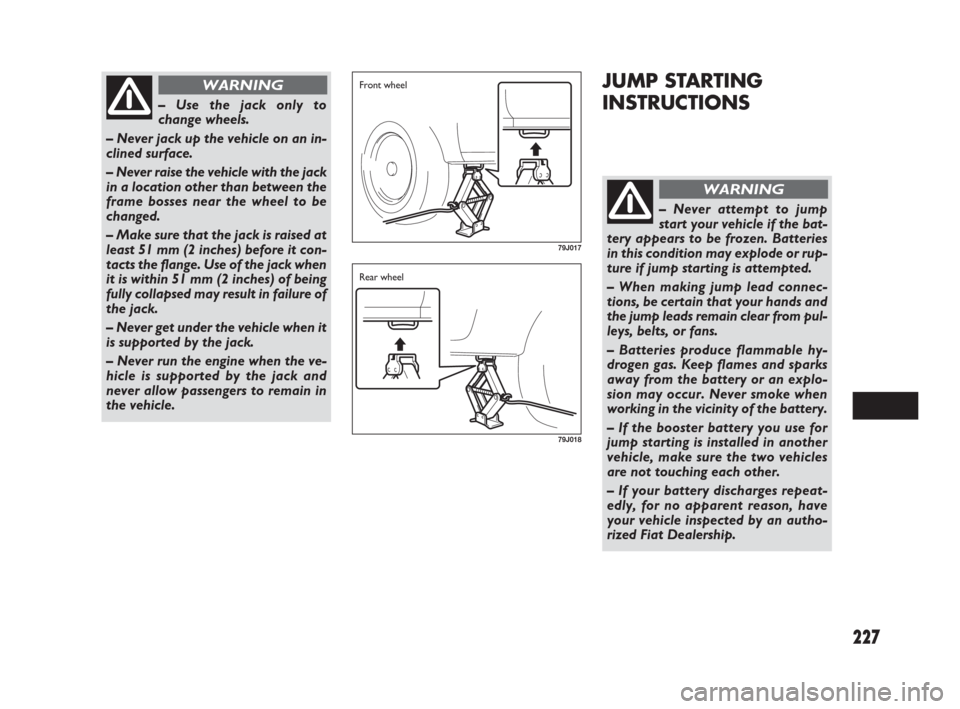
227
JUMP STARTING
INSTRUCTIONS
– Use the jack only to
change wheels.
– Never jack up the vehicle on an in-
clined surface.
– Never raise the vehicle with the jack
in a location other than between the
frame bosses near the wheel to be
changed.
– Make sure that the jack is raised at
least 51 mm (2 inches) before it con-
tacts the flange. Use of the jack when
it is within 51 mm (2 inches) of being
fully collapsed may result in failure of
the jack.
– Never get under the vehicle when it
is supported by the jack.
– Never run the engine when the ve-
hicle is supported by the jack and
never allow passengers to remain in
the vehicle.
WARNING
79J017
79J018
Front wheel
Rear wheel
– Never attempt to jump
start your vehicle if the bat-
tery appears to be frozen. Batteries
in this condition may explode or rup-
ture if jump starting is attempted.
– When making jump lead connec-
tions, be certain that your hands and
the jump leads remain clear from pul-
leys, belts, or fans.
– Batteries produce flammable hy-
drogen gas. Keep flames and sparks
away from the battery or an explo-
sion may occur. Never smoke when
working in the vicinity of the battery.
– If the booster battery you use for
jump starting is installed in another
vehicle, make sure the two vehicles
are not touching each other.
– If your battery discharges repeat-
edly, for no apparent reason, have
your vehicle inspected by an autho-
rized Fiat Dealership.
WARNING
225-232 Fiat16 New GB 27-11-2007 11:53 Pagina 227
Page 229 of 266
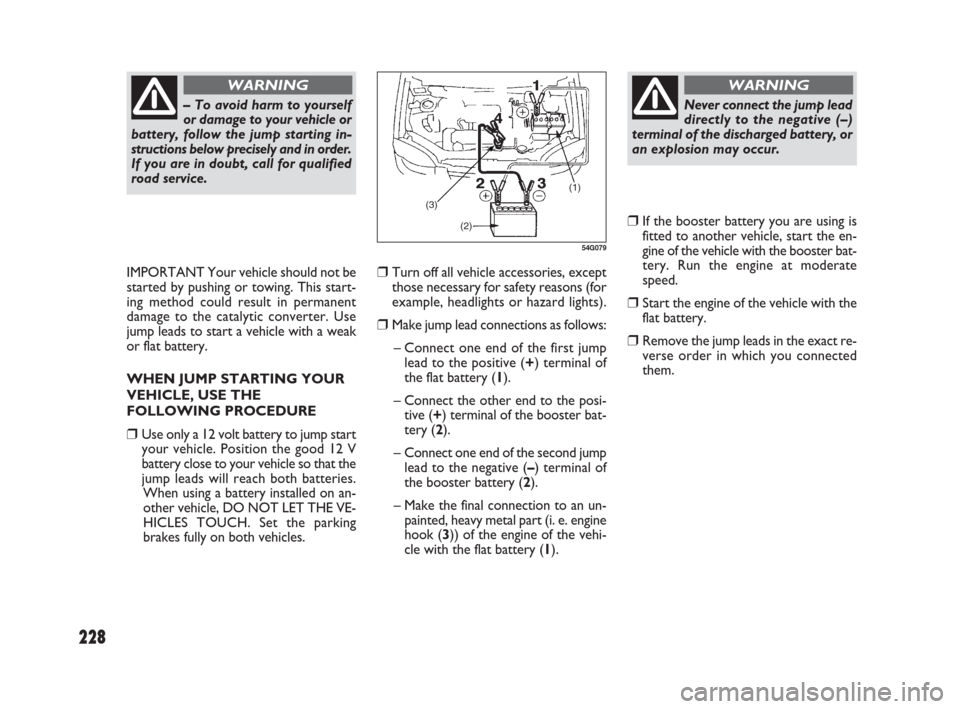
228
❒Turn off all vehicle accessories, except
those necessary for safety reasons (for
example, headlights or hazard lights).
❒Make jump lead connections as follows:
– Connect one end of the first jump
lead to the positive (+) terminal of
the flat battery (1).
– Connect the other end to the posi-
tive (+) terminal of the booster bat-
tery (2).
– Connect one end of the second jump
lead to the negative (–) terminal of
the booster battery (2).
– Make the final connection to an un-
painted, heavy metal part (i. e. engine
hook (3)) of the engine of the vehi-
cle with the flat battery (1).
❒If the booster battery you are using is
fitted to another vehicle, start the en-
gine of the vehicle with the booster bat-
tery. Run the engine at moderate
speed.
❒Start the engine of the vehicle with the
flat battery.
❒Remove the jump leads in the exact re-
verse order in which you connected
them. IMPORTANT Your vehicle should not be
started by pushing or towing. This start-
ing method could result in permanent
damage to the catalytic converter. Use
jump leads to start a vehicle with a weak
or flat battery.
WHEN JUMP STARTING YOUR
VEHICLE, USE THE
FOLLOWING PROCEDURE
❒Use only a 12 volt battery to jump start
your vehicle. Position the good 12 V
battery close to your vehicle so that the
jump leads will reach both batteries.
When using a battery installed on an-
other vehicle, DO NOT LET THE VE-
HICLES TOUCH. Set the parking
brakes fully on both vehicles.
– To avoid harm to yourself
or damage to your vehicle or
battery, follow the jump starting in-
structions below precisely and in order.
If you are in doubt, call for qualified
road service.
WARNING
(1)
(3)
(2)
54G079
Never connect the jump lead
directly to the negative (–)
terminal of the discharged battery, or
an explosion may occur.
WARNING
225-232 Fiat16 New GB 27-11-2007 11:53 Pagina 228
Page 231 of 266
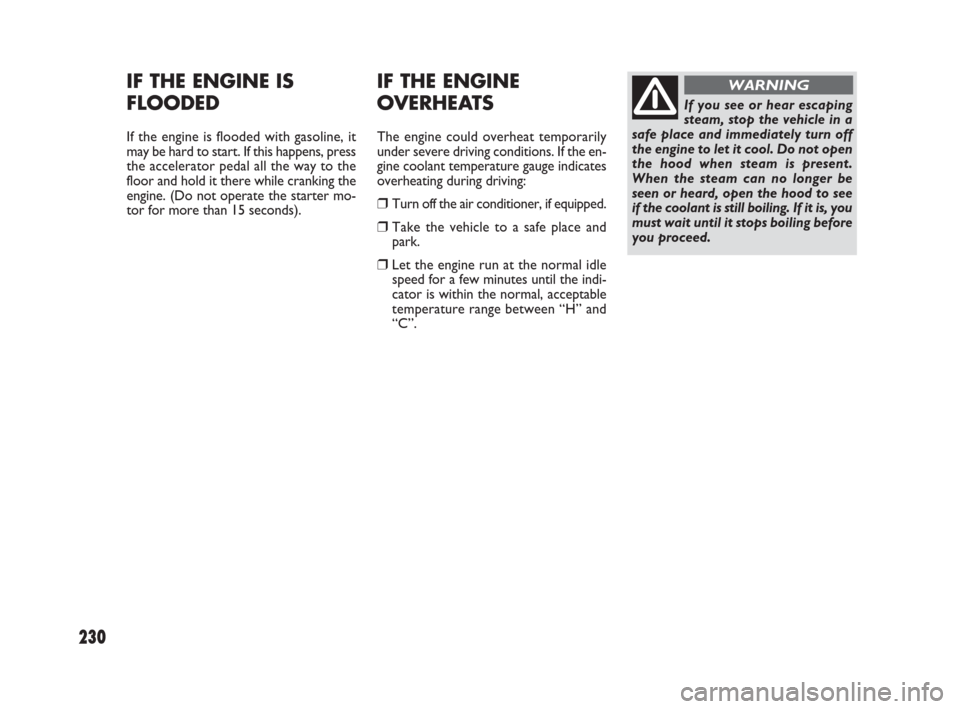
230
IF THE ENGINE
OVERHEATS
The engine could overheat temporarily
under severe driving conditions. If the en-
gine coolant temperature gauge indicates
overheating during driving:
❒Turn off the air conditioner, if equipped.
❒Take the vehicle to a safe place and
park.
❒Let the engine run at the normal idle
speed for a few minutes until the indi-
cator is within the normal, acceptable
temperature range between “H” and
“C”.
IF THE ENGINE IS
FLOODED
If the engine is flooded with gasoline, it
may be hard to start. If this happens, press
the accelerator pedal all the way to the
floor and hold it there while cranking the
engine. (Do not operate the starter mo-
tor for more than 15 seconds).
If you see or hear escaping
steam, stop the vehicle in a
safe place and immediately turn off
the engine to let it cool. Do not open
the hood when steam is present.
When the steam can no longer be
seen or heard, open the hood to see
if the coolant is still boiling. If it is, you
must wait until it stops boiling before
you proceed.
WARNING
225-232 Fiat16 New GB 27-11-2007 11:53 Pagina 230
Page 232 of 266
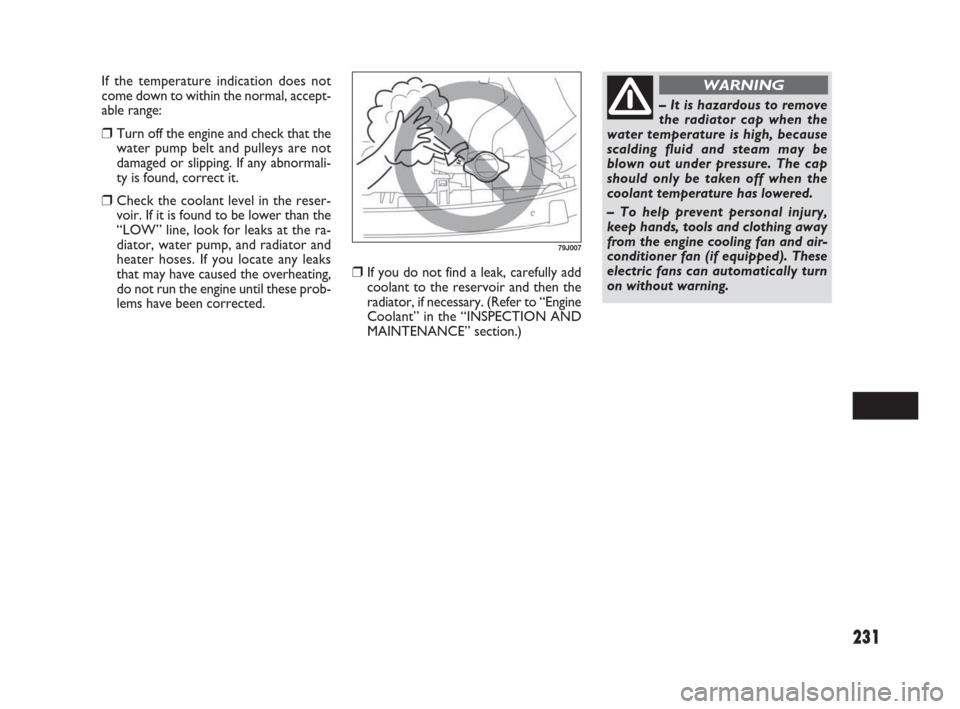
231
❒If you do not find a leak, carefully add
coolant to the reservoir and then the
radiator, if necessary. (Refer to “Engine
Coolant” in the “INSPECTION AND
MAINTENANCE” section.) If the temperature indication does not
come down to within the normal, accept-
able range:
❒Turn off the engine and check that the
water pump belt and pulleys are not
damaged or slipping. If any abnormali-
ty is found, correct it.
❒Check the coolant level in the reser-
voir. If it is found to be lower than the
“LOW” line, look for leaks at the ra-
diator, water pump, and radiator and
heater hoses. If you locate any leaks
that may have caused the overheating,
do not run the engine until these prob-
lems have been corrected.
79J007
– It is hazardous to remove
the radiator cap when the
water temperature is high, because
scalding fluid and steam may be
blown out under pressure. The cap
should only be taken off when the
coolant temperature has lowered.
– To help prevent personal injury,
keep hands, tools and clothing away
from the engine cooling fan and air-
conditioner fan (if equipped). These
electric fans can automatically turn
on without warning.
WARNING
225-232 Fiat16 New GB 27-11-2007 11:53 Pagina 231
Page 236 of 266
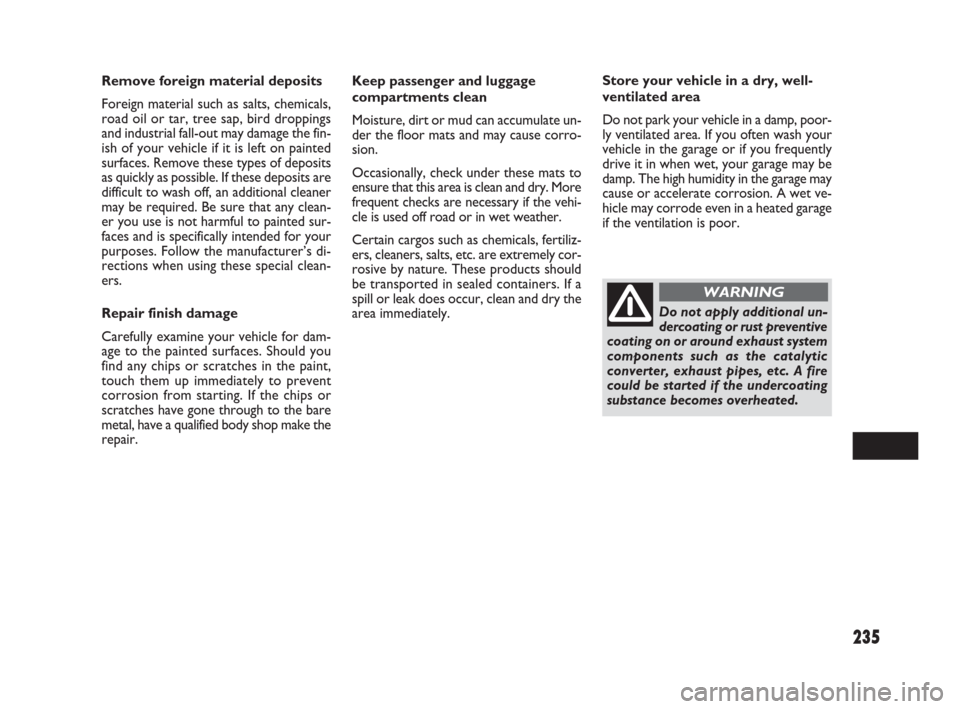
235
Keep passenger and luggage
compartments clean
Moisture, dirt or mud can accumulate un-
der the floor mats and may cause corro-
sion.
Occasionally, check under these mats to
ensure that this area is clean and dry. More
frequent checks are necessary if the vehi-
cle is used off road or in wet weather.
Certain cargos such as chemicals, fertiliz-
ers, cleaners, salts, etc. are extremely cor-
rosive by nature. These products should
be transported in sealed containers. If a
spill or leak does occur, clean and dry the
area immediately.Store your vehicle in a dry, well-
ventilated area
Do not park your vehicle in a damp, poor-
ly ventilated area. If you often wash your
vehicle in the garage or if you frequently
drive it in when wet, your garage may be
damp. The high humidity in the garage may
cause or accelerate corrosion. A wet ve-
hicle may corrode even in a heated garage
if the ventilation is poor. Remove foreign material deposits
Foreign material such as salts, chemicals,
road oil or tar, tree sap, bird droppings
and industrial fall-out may damage the fin-
ish of your vehicle if it is left on painted
surfaces. Remove these types of deposits
as quickly as possible. If these deposits are
difficult to wash off, an additional cleaner
may be required. Be sure that any clean-
er you use is not harmful to painted sur-
faces and is specifically intended for your
purposes. Follow the manufacturer’s di-
rections when using these special clean-
ers.
Repair finish damage
Carefully examine your vehicle for dam-
age to the painted surfaces. Should you
find any chips or scratches in the paint,
touch them up immediately to prevent
corrosion from starting. If the chips or
scratches have gone through to the bare
metal, have a qualified body shop make the
repair.
Do not apply additional un-
dercoating or rust preventive
coating on or around exhaust system
components such as the catalytic
converter, exhaust pipes, etc. A fire
could be started if the undercoating
substance becomes overheated.
WARNING
233-238 Fiat16 New GB 27-11-2007 11:53 Pagina 235
Page 237 of 266
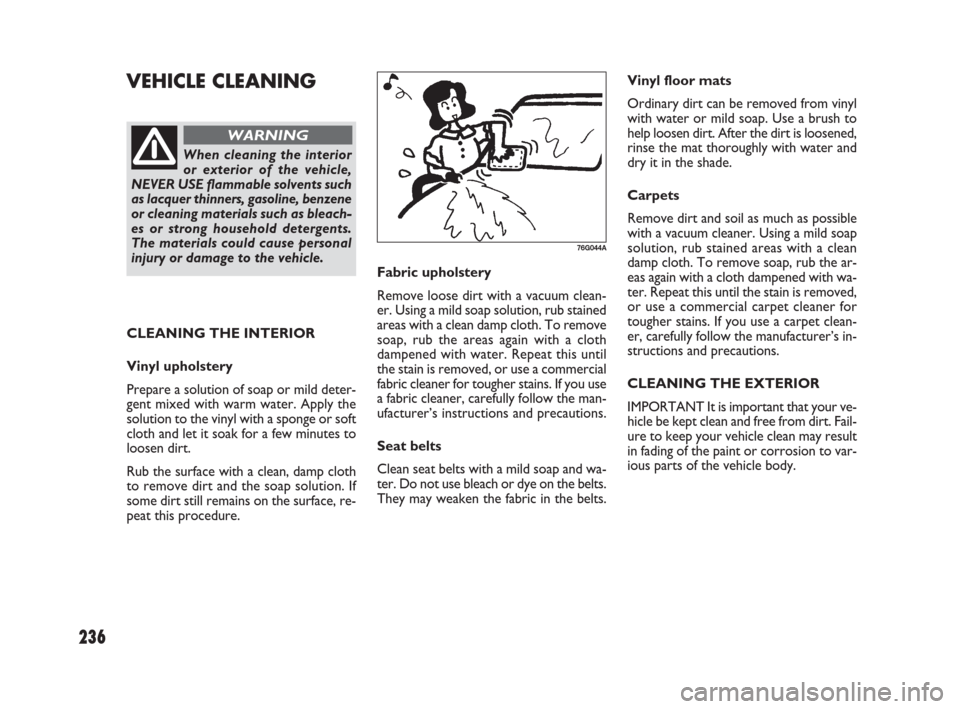
236
Fabric upholstery
Remove loose dirt with a vacuum clean-
er. Using a mild soap solution, rub stained
areas with a clean damp cloth. To remove
soap, rub the areas again with a cloth
dampened with water. Repeat this until
the stain is removed, or use a commercial
fabric cleaner for tougher stains. If you use
a fabric cleaner, carefully follow the man-
ufacturer’s instructions and precautions.
Seat belts
Clean seat belts with a mild soap and wa-
ter. Do not use bleach or dye on the belts.
They may weaken the fabric in the belts.Vinyl floor mats
Ordinary dirt can be removed from vinyl
with water or mild soap. Use a brush to
help loosen dirt. After the dirt is loosened,
rinse the mat thoroughly with water and
dry it in the shade.
Carpets
Remove dirt and soil as much as possible
with a vacuum cleaner. Using a mild soap
solution, rub stained areas with a clean
damp cloth. To remove soap, rub the ar-
eas again with a cloth dampened with wa-
ter. Repeat this until the stain is removed,
or use a commercial carpet cleaner for
tougher stains. If you use a carpet clean-
er, carefully follow the manufacturer’s in-
structions and precautions.
CLEANING THE EXTERIOR
IMPORTANT It is important that your ve-
hicle be kept clean and free from dirt. Fail-
ure to keep your vehicle clean may result
in fading of the paint or corrosion to var-
ious parts of the vehicle body.
VEHICLE CLEANING
When cleaning the interior
or exterior of the vehicle,
NEVER USE flammable solvents such
as lacquer thinners, gasoline, benzene
or cleaning materials such as bleach-
es or strong household detergents.
The materials could cause personal
injury or damage to the vehicle.
WARNING
CLEANING THE INTERIOR
Vinyl upholstery
Prepare a solution of soap or mild deter-
gent mixed with warm water. Apply the
solution to the vinyl with a sponge or soft
cloth and let it soak for a few minutes to
loosen dirt.
Rub the surface with a clean, damp cloth
to remove dirt and the soap solution. If
some dirt still remains on the surface, re-
peat this procedure.
76G044A
233-238 Fiat16 New GB 27-11-2007 11:53 Pagina 236
Page 238 of 266
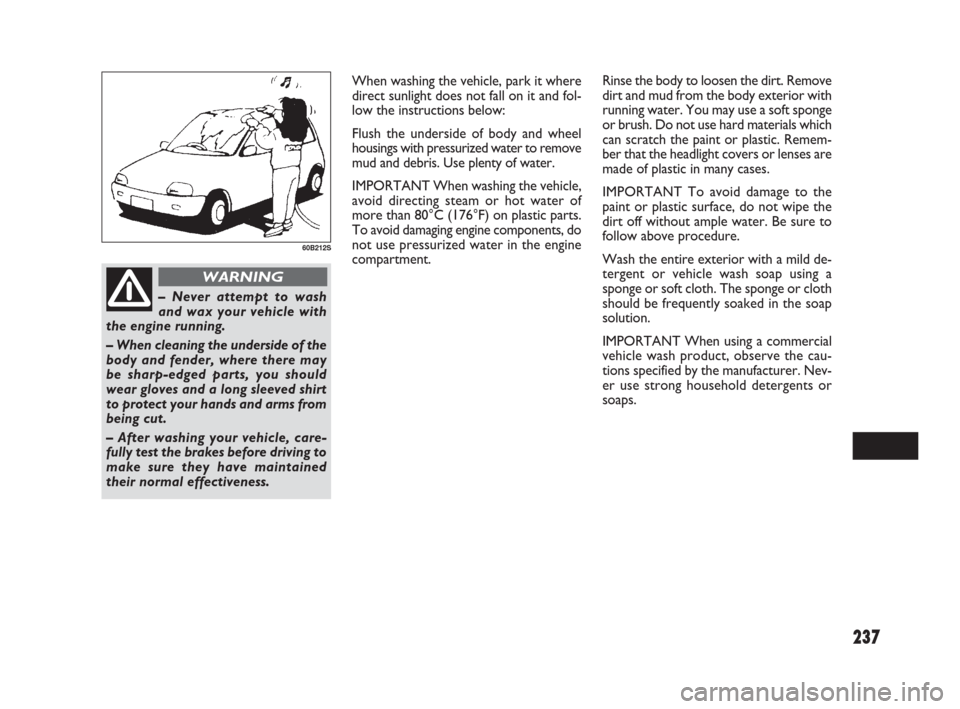
237
When washing the vehicle, park it where
direct sunlight does not fall on it and fol-
low the instructions below:
Flush the underside of body and wheel
housings with pressurized water to remove
mud and debris. Use plenty of water.
IMPORTANT When washing the vehicle,
avoid directing steam or hot water of
more than 80°C (176°F) on plastic parts.
To avoid damaging engine components, do
not use pressurized water in the engine
compartment.Rinse the body to loosen the dirt. Remove
dirt and mud from the body exterior with
running water. You may use a soft sponge
or brush. Do not use hard materials which
can scratch the paint or plastic. Remem-
ber that the headlight covers or lenses are
made of plastic in many cases.
IMPORTANT To avoid damage to the
paint or plastic surface, do not wipe the
dirt off without ample water. Be sure to
follow above procedure.
Wash the entire exterior with a mild de-
tergent or vehicle wash soap using a
sponge or soft cloth. The sponge or cloth
should be frequently soaked in the soap
solution.
IMPORTANT When using a commercial
vehicle wash product, observe the cau-
tions specified by the manufacturer. Nev-
er use strong household detergents or
soaps.
– Never attempt to wash
and wax your vehicle with
the engine running.
– When cleaning the underside of the
body and fender, where there may
be sharp-edged parts, you should
wear gloves and a long sleeved shirt
to protect your hands and arms from
being cut.
– After washing your vehicle, care-
fully test the brakes before driving to
make sure they have maintained
their normal effectiveness.
WARNING
60B212S
233-238 Fiat16 New GB 27-11-2007 11:53 Pagina 237
Page 245 of 266
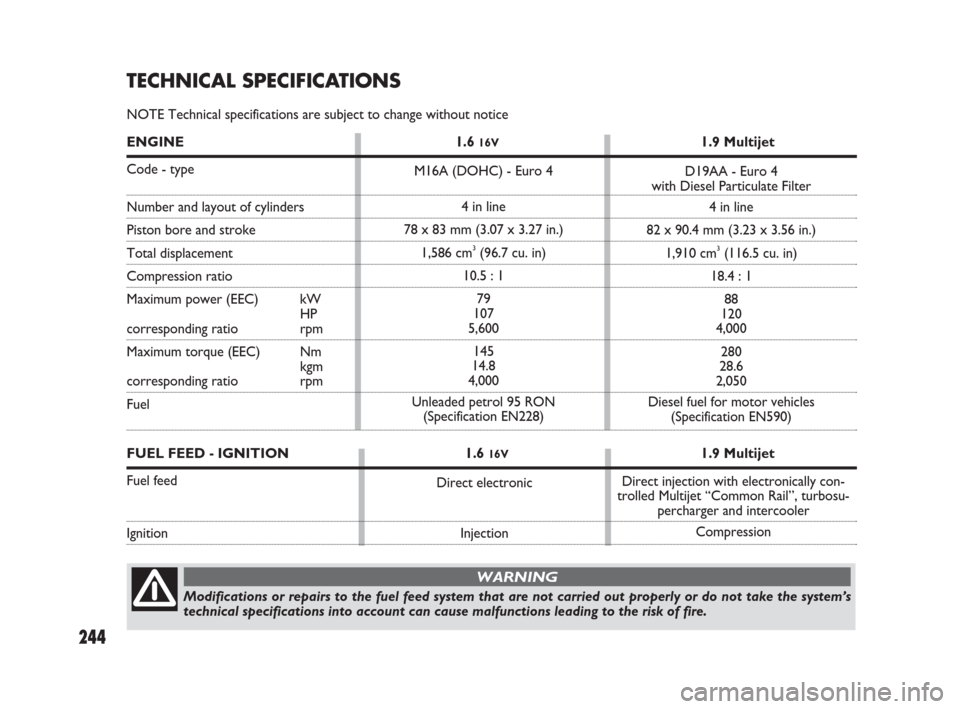
244
TECHNICAL SPECIFICATIONS
NOTE Technical specifications are subject to change without notice
M16A (DOHC) - Euro 4
4 in line
78 x 83 mm (3.07 x 3.27 in.)
1,586 cm
3(96.7 cu. in)
10.5 : 1
79
107
5,600
145
14.8
4,000
Unleaded petrol 95 RON
(Specification EN228)D19AA - Euro 4
with Diesel Particulate Filter
4 in line
82 x 90.4 mm (3.23 x 3.56 in.)
1,910 cm3(116.5 cu. in)
18.4 : 1
88
120
4,000
280
28.6
2,050
Diesel fuel for motor vehicles
(Specification EN590)
ENGINE 1.6 16V1.9 Multijet
Code - type
Number and layout of cylinders
Piston bore and stroke
Total displacement
Compression ratio
Maximum power (EEC) kW
HP
corresponding ratio rpm
Maximum torque (EEC) Nm
kgm
corresponding ratio rpm
Fuel
Direct electronic
InjectionDirect injection with electronically con-
trolled Multijet “Common Rail”, turbosu-
percharger and intercooler
Compression
FUEL FEED - IGNITION 1.6 16V1.9 Multijet
Fuel feed
Ignition
Modifications or repairs to the fuel feed system that are not carried out properly or do not take the system’s
technical specifications into account can cause malfunctions leading to the risk of fire.
WARNING
243-248 Fiat16 New GB 27-11-2007 11:54 Pagina 244